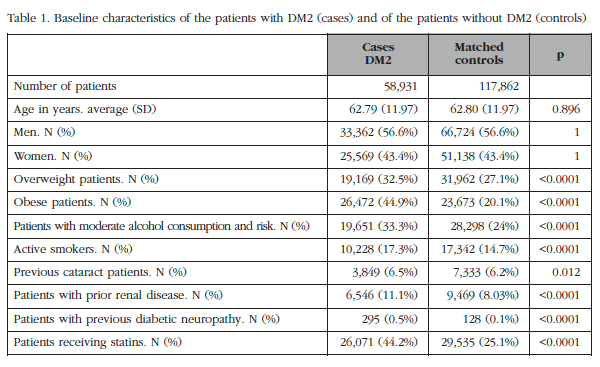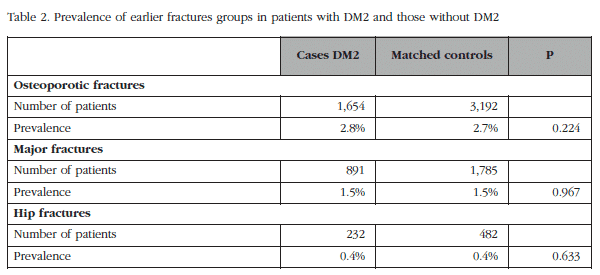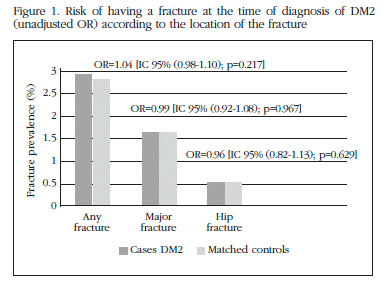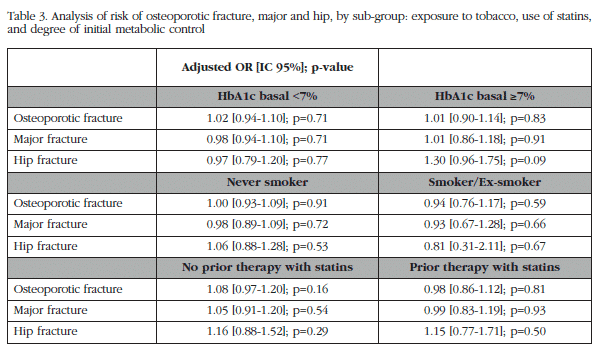Meu SciELO
Serviços Personalizados
Journal
Artigo
Indicadores
-
 Citado por SciELO
Citado por SciELO -
 Acessos
Acessos
Links relacionados
-
 Citado por Google
Citado por Google -
 Similares em
SciELO
Similares em
SciELO -
 Similares em Google
Similares em Google
Compartilhar
Revista de Osteoporosis y Metabolismo Mineral
versão On-line ISSN 2173-2345versão impressa ISSN 1889-836X
Rev Osteoporos Metab Miner vol.5 no.2 Madrid Abr./Jun. 2013
https://dx.doi.org/10.4321/S1889-836X2013000200003
Risk of fracture associated with states prior to the diagnosis of diabetes mellitus type 2: Nested case-controlled study (DIAFOS cohort)
Riesgo de fractura asociado a los estadios previos al diagnóstico de diabetes mellitus tipo 2: Estudio de casos-controles anidados (cohorte DIAFOS)
Martínez-Laguna D.1,2, Nogués-Solán X.2,3, Díez-Pérez A.3, Soria-Castro A.1,2, Carbonell-Abella C.1,2, Arias-Moliz I.1, Estrada-Laza P.1, Prieto-Alhambra D.1,2,3,4
1 Atención Primaria Barcelona Ciudad - Instituto Catalán de la Salud
2 Grupo de Investigación GREMPAL - IDIAP Jordi Gol - Universidad Autónoma de Barcelona
3 URFOA y Departamento Medicina Interna - Parque de Salud MAR - RETICEF
4 Departamento de Ortopedia - Reumatología y Ciencias Musculoesqueléticas de Nuffield - Universidad de Oxford (Reino Unido)
Scholarship Working with Clinical Research Fellowship FEIOMM 2011.
Italfármaco Award for Best Oral Presentations of the XVII Congress of SEIOMM (Cuenca, 2012).
SUMMARY
Backgound: In phases prior to the diagnosis of diabetes mellitus type 2 there is an increased risk of cardiovascular disease, but it is not known if this is the case in relation to the risk of fractures.
Objective: To compare the prevalence of fracture in cases of diabetes mellitus and in matched controls.
Material and method: Nested case-control study in a population-based cohort. All patients diagnosed with type 2 diabetes in the period 2006-2011 were included, as were, for each of these patients, two control subjects of the same age, gender, and from the same medical centre, without diabetes. Any fractures, cerebro-vascular accidents and ischemic cardiopathy prevalent in these patients were identified using ICD codes 10. The prevalence of osteoporotic, major and hip fractures, and of cardiovascular disease at the time of diagnosis for the diabetic subjects, and on the same date for the matched controls, were calculated. Using conditional logistical regression the odds ratios (OR) were calculated, adjusting for body mass index, smoking, alcoholism, use of statins, cardiovascular disease and diabetic complications.
Results: 58,931 diabetic patients and 117,862 controls were identified. At the date of diagnosis the diabetic patients had a higher prevalence of cerebro-vascular accident (4.9% vs 3.5%; p< 0.001) and ischemic cardiopathy (8.1% vs 4.7%; p< 0.001). On the other hand, the prevalence of osteoporotic fracture (2.8% vs 2.7%; p= 0.22), hip fracture (0.4% vs 0.4%; p=0.63) and major fracture (1.5% vs 1.5%; p=0.97) was similar in both groups. The adjusted ORs were: 1.2 (CI 95%: 0.96-1.09), 1.08 (CI 95%: 0.90-1.28), and 0.99 (CI 95%: 0.91-1.09), respectively.
Conclusions: The type 2 diabetic patients had a higher prevalence of cardiovascular disease at the time of diagnosis. However, their risk of fracture was similar to the non-diabetic control subjects.
Key words: diabetes mellitus type 2, osteoporotic fractures, cardiovascular disease, prevalence.
RESUMEN
Fundamento: En fases previas al diagnóstico de diabetes
mellitus tipo 2 existe riesgo aumentado de enfermedad cardiovascular, pero se desconoce si esto sucede en lo relativo al riesgo de fracturas.
Objetivo: Comparar la prevalencia de fractura en casos incidentes de diabetes
mellitus y en controles apareados.
Material y método: Estudio de casos-controles anidados en una cohorte de base poblacional. Se incluyó a todos los pacientes diabéticos tipo 2 diagnosticados en el periodo 2006-2011 y, por cada uno, a dos sujetos controles sin diabetes de igual edad, género y centro de salud. Se identificaron en ellos fracturas, accidentes cerebro-vascular y cardiopatía isquémica prevalentes utilizando códigos CIE10. Se calculó la prevalencia de fracturas osteoporóticas, mayores y de cadera, y de enfermedad cardiovascular en el momento del diagnóstico para los sujetos diabéticos, y en esa misma fecha índice para los controles apareados. Mediante regresión logística condicional se calcularon las
odds ratios (OR) ajustadas por índice masa corporal, tabaquismo, enolismo, uso de estatinas, enfermedad cardiovascular y complicaciones diabéticas.
Resultados: Se identificaron 58.931 pacientes diabéticos y 117.862 controles. En la fecha del diagnóstico, los pacientes diabéticos presentaban mayor prevalencia de accidente cerebro-vascular (4,9% vs. 3,5%; p<0,001) y de cardiopatía isquémica (8,1% vs. 4,7%; p<0,001). Por el contrario, la prevalencia de fractura osteoporótica (2,8% vs. 2,7%; p=0,22), fractura de cadera (0,4% vs. 0,4%; p=0,63) y fractura mayor (1,5% vs. 1,5%; p=0,97) fue similar en ambos grupos. Las OR ajustadas fueron: 1,02 (IC 95%: 0,96-1,09), 1,08 (IC 95%: 0,90-1,28), y 0,99 (IC 95%: 0,91-1,09), respectivamente.
Conclusiones: Los pacientes diabéticos tipo 2 presentan mayor prevalencia de enfermedad cardiovascular en el momento del diagnóstico. Sin embargo, su riesgo de fractura es similar al de los sujetos controles no diabéticos.
Palabras clave: diabetes mellitus tipo 2, fracturas osteoporóticas, enfermedad cardiovascular, prevalencia.
Introduction
Diabetes mellitus and osteoporosis are two diseases which are highly prevalent in our environment. According to the estimates of the International Diabetes Federation, nearly 245 million people suffered from diabetes mellitus type (DM2) in 2006 [1]. The prevalence of DM2 in adults in Spain varies between 12 and 15% [2]. Similarly, the overall prevalence of osteoporosis in our environment is 12.73% in women and 4.15% in men [3].
Although the relationship between diabetes mellitus and cardiovascular disease is well known, less data is available regarding the possible relationship between DM2 and osteoporosis. Different epidemiological studies indicate an increase in bone mass in type 2 diabetic patients while contrary to what would be expected, there is an increased risk of fracture, both in the femur and the vertebrae and other locations [4-6].
According to the natural history of DM2 [7], patients may pass through an average of 5-10 years in a number of prior states characterised by alterations in carbohydrate metabolism: pre-diabetes. What is meant by pre-diabetes is those intermediate situations between normality and diabetes. Two states may be distinguished: impaired glucose tolerance (IGT), defined by the American Diabetes Association (ADA) as a value of glycemia of between 140 and 199 mg/dl 2 hours after a tolerance test with 75 g of glucose taken orally; and impaired fasting glucose (IFG) defined as a baseline glycemia of between 100 and 125 mg/dl. Although they should not be considered to be diseases, these pre-diabetic states are associated with an increased cardiovascular morbimortality [8], which is greater in patients with IGT than in those with IFG [9]. There is little data available on the risk of fracture in these states; the Rotterdam study [10] showed that those patients with IGT had a significant reduction in the risk of fracture.
As a consequence, this study was designed with the objective of analysing the prevalence of fractures at the time of diagnosis of DM2 in a population-based cohort.
Material and method
This is an nested case-controlled study in a population-based cohort (DIAFOS cohort). The data were obtained from the SIDIAP database, which contains the clinical information recorded by primary care doctors working in the Catalan Institute of Health (Instituto Catalán de la Salud (ICS) ), the main provider of health services in Catalonia, as well as pharmacy invoice data, analysis data from reference laboratories and reports from hospitals in the public health system. This database includes information from approximately 5.8 million patients (approximately 80% of the Catalan population). After a quality control, information from almost 5 million people was available, demographically representative of this population. The quality of the information which SIDIAP contains has been validated [11]; earlier studies validated the records of incidents of fracture in comparison with classical cohorts [12] and the data related to the records of DM2 [13].
From all the patients included in SIDIAP, those who had a diagnosis of DM2 in a period between 01/01/2006 and 31/12/2011 were identified, using the CIE codes 10. From all those diabetes-free (types 1 and 2) SIDIAP participants two controls per case were randomly selected, matched by year of birth, sex and health centre.
Data was collected regarding descriptive variables: age, sex, body mass index, presence of complications associated with diabetes mellitus (cataracts, nephropathy and diabetic neuropathy), smoking (smoker, non-smoker, ex-smoker), alcohol consumption (in average units of weekly consumption, classified as: low risk consumption, when in men it was between 17 and 28, or in women, between 11 and 17 units; risky consumption, when in men it was higher than 28 and in women higher than 17 units) and use of statins (ATC codes C10AA01 to C10AA08). The presence of ischemic cardiopathy (stable angina, unstable angina or myocardial infarction) and cerebrovascular disease (cerebral infarction or transitory ischemic accident) at the time of diagnosis with DM2 using CIE codes 10. In addition, all the clinical fractures recorded in the computerised clinical history prior to the diabetes mellitus diagnosis were collected by means of a review of CIE codes 10; The SIDIAP database does not contain imaging test information, for which reason it was not possible to radiologically confirm the fractures. Three different types of fracture were distinguished: osteoporotic fractures (in any location except fingers or toes, face or cranium); major fractures according to FRAX© [14] (hip, wrist, forearm, humerus and vertebrae) and hip fracture.
Statistical analysis
The characteristics of the population studied were described by means of a descriptive univariate analysis, calculating the mean and standard deviation for continuous variables and absolute frequency and percentage for categorical variables. To compare the prevalence of cardiovascular disease and of fracture in both groups the chi squared test was used. Using conditional logistic regression the unadjusted odds ratios were calculated for cardiovascular disease and fractures, and adjusted for the following confusion factors defined a priori according to the available literature and biological plausibility: body mass index, smoking, alcoholism, use of statins, cardiovascular disease, cataracts, nephropathy and diabetic neuropathy. All the statistical tests were carried out with a confidence (CI) of 95% and assuming a bilateral contrast.
The SIDIAP database provided purely observational data for this study. The SIDIAP data are totally anonymous and identified by an internal code created at the time of incorporation of the data, a fact which makes impossible the identification of the subjects included in the study. The approval was obtained of the local ethics committee for clinical research (CEIC IDIAP Jordi Gol).
Results
58,931 patients were diagnosed with DM2 between 01/01/2006 and 31/12/2011, and 117,862 matched controls were selected. In Table 1 the baseline characteristics of both cohorts are described, which were, as to be expected, same sex and similar age, but with a higher proportion of patients who were obese or overweight, smokers and receiving statins among the diabetics.
In relation to the presence of cardiovascular disease at the time of diagnosis, 4,799 (8.1%) cases and 5,535 (4.7%) controls had ischemic cardiopathy prior to the index date (p<0.0001); and 2,895 (4.9%) and 4,125 (3.5%), respectively, had cerebrovascular disease (p<0.0001). The corresponding ORs were 1.79 (95% CI: 1.73-1.87; p<0.0001) for ischemic cardiopathy and 1.42 (95% CI: 1.36-1.49; p<0.0001) for cerebrovascular disease).
The prevalence of osteoporotic fractures, major and hip, was similar and without statistically significant differences (Table 2). Those patients with DM2 had at the time of diagnosis a similar risk of fracture to the non-diabetic controls (Figure 1). The adjusted ORs were: for osteoporotic fractures, 1.02 (95% CI: 0.96-1.09; p=0.46); for major fractures, 0.99 (95% CI: 0.91-1.09; p=0.93); and for hip fracture, 1.08 (95% CI: 0.90-1.28; p=0.39).
In analysing patient sub-groups according to their exposure to tobacco, use of statins or degree of control of the DM2 starting (defined by HbA1c <7% or ≥7%), no statistically significant differences in the risk of osteoporotic fractures, major or hip, were observed (Table 3). Those patients with an initial HbA1c above 7% have a risk of fracture of the femur very close to being statistically significant (adjusted OR=1.30; 95% CI: 0.96-1.75; p=0.09).
Discussion
The patients with DM2 have an increased risk of around 70% and 40% of ischemic cardiopathy and cerebrovascular disease respectively, compared with the matched controls. A recent meta-analysis [15] of patients with pre-diabetes (including patients with IGT and IFG) concluded that these have an increase of 26% in cerebrovascular disease (RR=1.26; 95% CI: 1.10-1.41; p<0.001). A study of patients with IFG [16], according to the criteria of the ADA (American Diabetes Association), found and increase in the risk of ischemic cardiopathy in women (OR=1.70; 95% CI:1.0-3.0; p=0.049).
However, according to the results of our study, the patients with DM2 did not have a higher probability of suffering a fracture (major or hip osteoporotic fracture) than the rest of the population at the time of diagnosis with diabetes. This suggests that the increase in risk associated with DM2 does not appear in the initial phases of the disease but with the development of the disease itself.
The mechanism by which DM2 favours the appearance of fractures is not clearly defined, even though different substances have been described which have a crucial role in the pathogeny of this association [17,18]. In carrying out an analysis by sub-groups we have observed that those patients with an initial HbA1c above 7% have a risk of hip fracture at the limit of statistical significance. Previous studies [18] show that a degree of deficient metabolic control is associated with higher levels of sclerostin, provoking a risk of fractures. Furthermore, high levels of glucose leads to an accumulation of degradation products in the bone matrix, which results in bone which is biomechanically less strong [19]. Although our study did not have available data on these substances, it not having found a higher incidence of fractures at the time of diagnosis of DM2 may support this hypothesis. The temporariness between the association of diabetes and fracture will be the object of a new prospective study in the follow up of the DIAFOS cohort.
As is to be expected, the patients with DM2 at the time of diagnosis have an increased risk of ischemic cardiopathy, as well as cerebrovascular disease, in comparison with the general population. Different epidemiological studies have shown that patients with glucose intolerance have a greater cardiovascular morbimortality [20]. Different mechanisms associated with hyperglycemia have been postulated as favouring arteriosclerosis, among which are endothelial dysfunction, oxidative stress and the formation of degradation products [21]. It is of interest to note that in the population of patients with DM2 in our study the proportion of patients who were overweight-obese and who were already receiving statins (indirect indicator of the presence of lipid metabolism disorder) was higher than in the controls. This may be explained by the fact that obesity and lipid metabolism disorders favour the appearance of carbohydrate metabolism disorder (impaired fasting glucose, glucose intolerance, diabetes or metabolic syndrome). In addition, the presence of a higher proportion of active smokers among those with diabetes type 2 may increase both the risk of suffering a cardiovascular event and fractures. The use of statins has been associated with a lower incidence of osteoporotic fractures [22], possibly due to the fact that it interferes in the same metabolic pathway, that of mevalonate, on which the bisphosphonates also act. A direct effect of statins has also been demonstrated in vitro in primary cultures of human osteoblasts [23]. However, its effects on bone are not very marked and do not, in our opinion, explain the lack of difference in the incidence of fractures. In any case, our analysis was adjusted for this possible confusion factor.
One of the limitations of our study is that the data comes from computerised clinical histories and, differently from the classical cohort study, may be underreported. This may result in bias in the random classification, which may lower the association between the predictor factors and the event of interest. In fact, the record of fractures in SIDIAP has been validated in comparison with the classical cohort studies and hospital discharge databases, and the data have a moderate sensitivity (nearly 70%) and a high specificity (>95%) [12]. On the other hand, this study has significant strengths, such as the high number of individuals, which allows the detection of statistically significant differences, even in cases where this is very limited. Therefore, we think that the lack of an increase in fractures at the time of diagnosis of DM2 is a consistent finding.
Conclusions
The DIAFOS cohort is made up of a population of patients newly diagnosed with diabetes mellitus type 2 in which the intention is to analyse the association between the diabetes and the presence of fractures. In this first analysis, using a nested case-controlled design within this cohort, we can conclude that at the time of diagnosis the diabetic patients did not have a higher risk of suffering a fracture than the general population, so that it appears to be the case that pre-diabetes does not cause an increased risk of suffering fractures, contrary to what happens with cardiovascular disease. So, these results do not support the need for specific evaluation of the risk of fractures in patients with a diagnosis of DM2 beyond what is normal in the general population.
Conflict of interest
The authors declare that they have no conflicts of interest.
![]() Correspondence:
Correspondence:
Daniel Martínez Laguna
c/Fluvià, 211
08020 Barcelona (España)
Correo electrónico:
34859dml@comb.cat
Date of receipt: 14/02/2013
Date of acceptance: 26/03/2013
Bibliography
1. Wild S, Roglic G, Green A, Sicree R, King H. Global prevalence of diabetes: estimates for the year 2000 and projections for 2030. Diabetes Care 2004;27:1047-53. [ Links ]
2. Soriguer F, Goday A, Bosch-Comas A, Bordiu E, Calle-Pascual A, Carmena R, et al. Prevalence of diabetes mellitus and impaired glucose regulations in Spain: the Di@bet.es Study. Diabetologia 2012;55:88-93. [ Links ]
3. Díaz M, García JJ, Carrasco Jl, Honorato J, Pérez R, Rapado A, et al. Prevalencia de la osteoporosis determinada por densitometría en la población femenina española. Med Clin (Barc) 2011;116:86-8. [ Links ]
4. Janghorbani M, van Dam RM, Willet WC, Hu FB. Systematic review of type 1 and type 2 diabetes mellitus and risk of fracture. Am J Epidemiol 2007;166:495-505. [ Links ]
5. Yamamoto M, Yamaguchi T, Yamauchi M, Kaji H, Sugimoto T. Diabetic patients have an increased risk of vertebral fractures independent of BMD or diabetic complications. J Bone Miner Res 2009;24:702-9. [ Links ]
6. Khalil N, Sutton-Tyrrell K, Strotmeyer ES, Greendale GA, Vuga M, Selzer F, et al. Menopausal bone changes and incident fractures in diabetic women: a cohort study. Osteoporos Int 2011;22:1367-76. [ Links ]
7. David M, Nathan MD, Initial management of glycemia in type 2 diabetes mellitus. N Engl J Med 2002;347:1342-9. [ Links ]
8. Coutinho M, Gerstein HC, Wang Y, Yusuf S. The relationship between glucose and incident events. A metaregression analysis of published data from 20 studies of 95783 individuals followed for 12.4 years. Diabetes Care 1999;22:233-40. [ Links ]
9. DECODE Study Group, the European Diabetes Epidemiology Group. Glucose tolerance and cardiovascular mortality: comparison of fasting and 2-hour diagnostic criteria. Arch Intern Med 2001;161:397-405. [ Links ]
10. De Liefde II, van der Klift M, de Laet CE, van Daele PL, Hofman A, Pols HA. Bone mineral density and fracture risk in type-2 diabetes mellitus: the Rotterdam study. Osteoporos Int 2005;16:1713-20. [ Links ]
11. García-Gil M, Hermosilla E, Prieto-Alhambra D, Fina F, Rossell M, Ramos R, et al. Construction and Validation of a Scoring System for Selction of High Quality Data in a Spanish Population Primary Care Database (SIDIAP). Inform Prim Care 2011;19:135-45. [ Links ]
12. Pagès-Castellà A, Carbonell-Abella C, Fina Avilés F, Alzamora M, Baena-Díez JM, Martínez-Laguna D, et al. Burden of osteoporotic fractures in primary health care in Catalonia (Spain): a population-based study. BMC Musculoskelet Disord 2012;13:79. [ Links ]
13. Vinagre I, Mata-Cases M, Hermosilla E, Morros R, Fina Avilés F, Rosell M, et al. Control of glycemia and cardiovascular risk factors in patients with type 2 diabetes in primary care in Catalonia (Spain). Diabetes Care 2012;35:774-9. [ Links ]
14 Kanis JA, Johnell O, Oden A, Johansson H, McCloskey E. FRAX and the assessment of fracture probability in men and women from the UK. Osteoporos Int 2008;19: 385-97. [ Links ]
15. Lee M, Saver JL, Hong KS, Song S, Chang KH, Ovbiagele B. Effect of pre-diabetes on future risk of stroke: meta-analysis. BMJ 2012;334:e3564. [ Links ]
16. Levitzky YS, Pencina MJ, D'Agostino RB, Meigs JB, Murabito JM, Vasan RS, et al. Impact of impaired fasting glucose on cardiovascular disease: the Framingham Heart Study. J Am Coll Cardiol 2008;51: 264-70. [ Links ]
17. Kanazawa I, Yamaguchi T, Yamamoto M, Yamauchi M, Yano S, Sugimoto T. Relationships between serum adiponectin levels versus bone mineral density, bone metabolic markers, and vertebral fractures in type 2 diabetes mellitus. Eur J Endocrinol 2009;160:265-73. [ Links ]
18. García-Martín A, Rozas-Moreno P, Reyes-García R, Morales-Santana S, García-Fontana B, García-Salcedo JA, et al. Circulating levels of sclerostin are increase in patients with type 2 diabetes mellitus. J Clin Endocrinol Metab 2012;97:234-41. [ Links ]
19. Viguet-Carrin S, Roux JP, Arlot ME, Merabet Z, Leeming DJ, Byrjalsen I, et al. Contribution of the advanced glycation end product pentosidine and of maturation of type I collagen to compressive biomechanical properties of lumbar vertebrae. Bone 2006;39:1073-9. [ Links ]
20. The DECODE study group. Glucose tolerance and mortality: comparison of WHO and American Diabetes Association diagnostic criteria. European diabetes epidemiology group. Diabetes epidemiology: collaborative analysis of diagnostic criteria in Europe. Lancet 1999;354:617-21. [ Links ]
21. Chu CS, Lee KT, Cheng KH, Lee MY, Kuo HF, Lin TH, et al. Postchallenge responses of nitrotyrosine and TNF-alpha during 75-g oral glucose tolerance test are associated with the presence of coronary artery diseases in patients with prediabetes. Cardiovasc Diabetol 2012;11:21. [ Links ]
22. Toh S, Hernández-Díaz S. Statins and fracture risk. A systematic review. Pharmacoepidemiol Drug Saf 2007;16:627-40. [ Links ]
23. Ruiz-Gaspa S, Nogués X, Enjuanes A, Monllau JC, Blanch J, Carreras R, et al. Simvastatin and atorvastatin enhance gene expression of collagen type 1 and osteocalcin in primary human osteoblasts and MG-63 cultures. J Cell Biochem 2007;101:1430-8. [ Links ]











 texto em
texto em 






